We have been talking about Astonia for a few months now. I wanted to share the map that we are currently using to help give some context for the sessions.
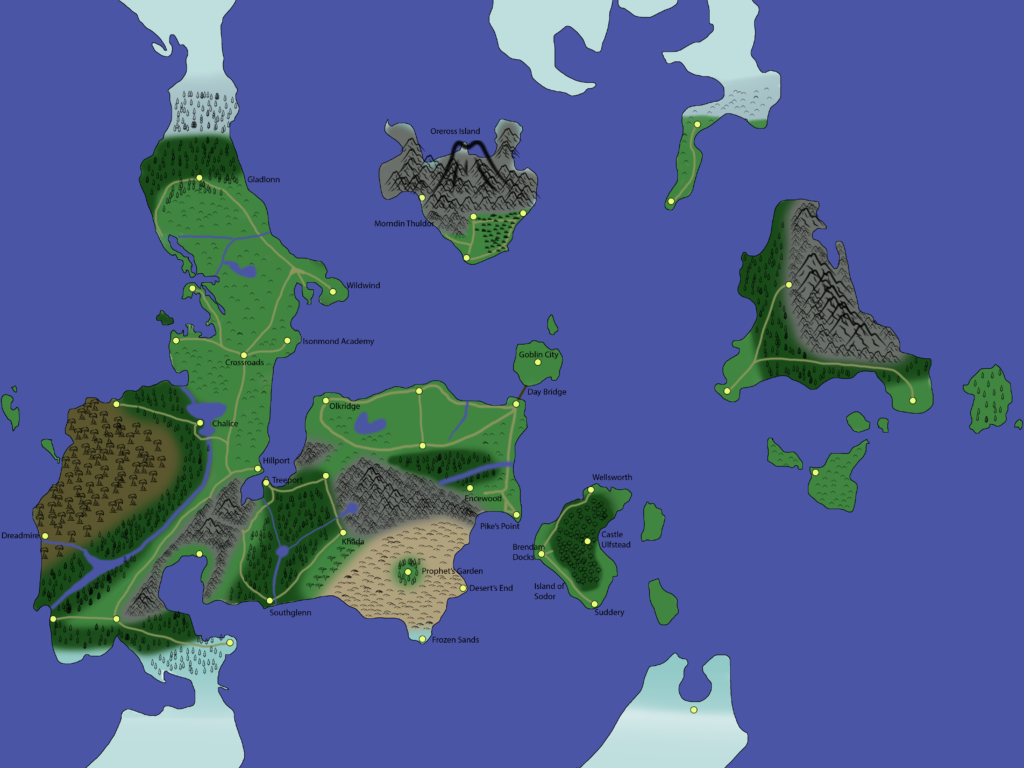
We have been talking about Astonia for a few months now. I wanted to share the map that we are currently using to help give some context for the sessions.


I love to come up with creative ways to describe a critical success. The rolling of a natural 20 on a 20 sided dice is a critical success for the task you are attempting to accomplish. You could think of some of the “people are awesome” or “win” videos on YouTube that are great examples of real people rolling natural 20s.
Every so often, a series of natural 20 rolls can lead to creative and wonderful experiences. Which leads us to the tale of Sir Nutcracker, an ordinary squirrel turned hero.
A shaman, paladin, rogue, and ranger were attempting to investigate a local business that may have been involved in some devious schemes in the town.
The player playing as the rogue was running a little late to our session, so his rogue initially woke up with a stomach ache. He unknowingly ate some goblin jerky that was given to him by the half-orc shaman.
The paladin, shaman, and ranger headed to the business to investigate. They arrived to find that the business appeared to be operating, but it was locked and closed. After checking all the entrances and knocking on a door or two, the trio could not find a way in. Knowing their rogue would be joining them soon, they decided to ask some of the closer shop owners a few questions.
The rogue soon arrived. The shaman asked the rogue to “verify” that the rear entrance was actually locked while the ranger and paladin continued with their interviews. The rogue may or may not have found the door wasn’t “locked” but just sticking. While waiting for the rogue to finish checking the door, the shaman attempted to befriend a squirrel. He fed it a few nuts and rolled high on a handle animal check.
As the party gathered to enter the building. They opened the door to find a long hallway and a few adjacent rooms. The shaman cast speak with animals and attempted to convince the squirrel that there was a large stash of nuts at the end of the hallway. I asked him to roll a bluff check and he rolled a natural 20.
Since the squirrel was already friendly towards him, the squirrel leapt into action. He darted down the hall, which may have set off any traps had they existed. The party entered the area to find a large room filled with goblins. After removing most of the goblin fifth, the party followed an injured goblin through an exit on the far side of the room.
After exiting, they found themselves in a small office. The goblin was barely seen running downstairs towards the basement. They heard a scratching sound coming from the door to their right. They prepared their weapons and readied attacks. The rogue throws open the door and in rushes our friendly squirrel. It begins frantically searching the room. The shaman cast speaks with animals again. He tells the squirrel that a goblin has taken the stash and ran down the stairs. He suggests that the squirrel attacks the goblin to get the nuts from him. One natural 20 later and the squirrel removes a rusty nail from a box and charges down the stairs.
As the party takes a second to heal, they soon follow down the stairs. As they come to the landing, they see the squirrel leap at the goblin, using its trusty rusty nail to pierce the goblins eye. Having been dealt the final blow to the goblin, the squirrel begins sifting through its pockets. The party rounds the corner and finds the villain they had been searching for. The shaman yells out in squirrel. He took them!!!
One natural 20 later, the squirrel has been convinced the villain is the real culprit and launches himself headlong into the evil monk. The squirrel rolls a natural 20 to hit the monk. The squirrel stabs him in the foot with the nail causing 2 points of damage. The monk takes his first turn and swiftly dispatches our small hero. As the fight continues, the rogue takes a hit or two and the paladin steps in to become the shield. The ranger, who has a soft spot for animals, scores the killing blow. When asked how she wants to finish him. The ranger says “I want to finish him off with the nail.” I describe how the ranger slices into the shoulder of the monk. As he falls to the floor, she reaches down, picks up the nail. As she slowly pushes it into his neck, she whispers, “This is for Sir Nutcracker.”
Our party mourned the loss of this courageous knight. But little did they know. The paladin’s god looked down on this heroic event. The god decided to resurrect and bless the squirrel. The squirrel became a ratfolk fighter that will return another day when the party’s need is greatest.

So there I was, on an airship with some of my best friends. We were travelling over the forbidden desert and things went bad. The engine fell off, propeller went for a spin, our energy crystal dislodged, and we lost our compass. At least our airship is still in one piece. We have a limited amount of water and the sands are piling up around us.
We must clear the sand, put our airship together, and escape before we are buried alive or we succumb to the elements.
The Archeologist: The Archeologist can remove 2 Sand markers form any single tile for 1 action.
Climber: The Climber can move to blocked tiles (tiles with 2 or more Sand markers on them). He may also take one other player with him whenever he moves. Pawns on the Climber’s tile are never buried and can leave the tile containing the Climber even if there are 2 or more Sand markers on it.
Explorer: The Explorer can move, remove sand, and may use Dune Blasters diagonally.
Meteorologist: The Meteorologist may spend actions to draw few Storm cards (1 card per action) at the end of her turn. She may also choose to spend 1 action to look at the top Storm cards, equal to the Storm level, and may place one at the bottom of the deck.
Navigator: The Navigator may move another player up to 3 unblocked tiles per action, including tunnels. She can move the Explorer diagonally and can move the Climber through blocked tiles. When moved in this way, the Climber can also use his power to take along 1 other player – including the Navigator!
Water Carrier: The Water Carrier can take 2 water from already excavated wells for 1 action. She may also give water to players on adjacent tiles for free at any time. The Water Carrier also starts with 5 (instead of 4) water.
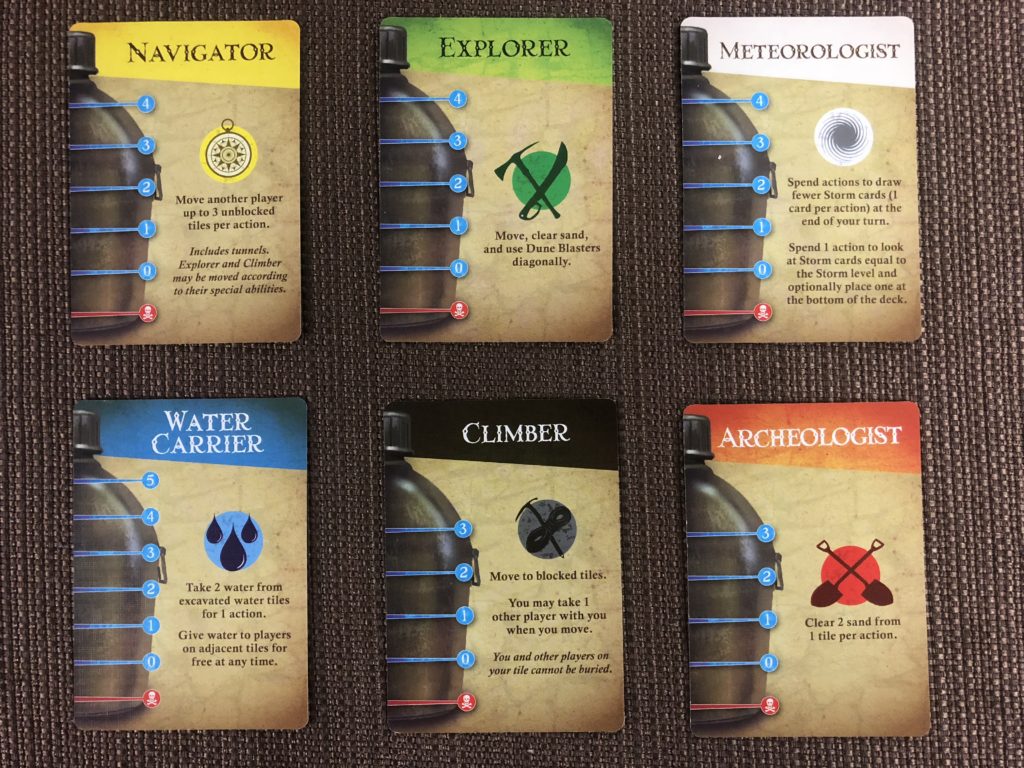
Before shuffling your tiles, you may want to examine them to understand what they look like, especially for new players. After familiarization, shuffle the tiles desert side up. No peaking from here on out.
Randomly place the tiles in a 5 X 5 grid with a tile missing in the center. The tiles should all be oriented in the same way, with the compass in the top left corner. Leave a small gap between tiles. The hole in the middle of the board represents the Sandstorm which will move around the board at the end of each turn.
Place 8 Sand markers on the tiles as shown. Place them with the lighter coloured side facing up. The rest of the tiles can be piled up to the side of the board.
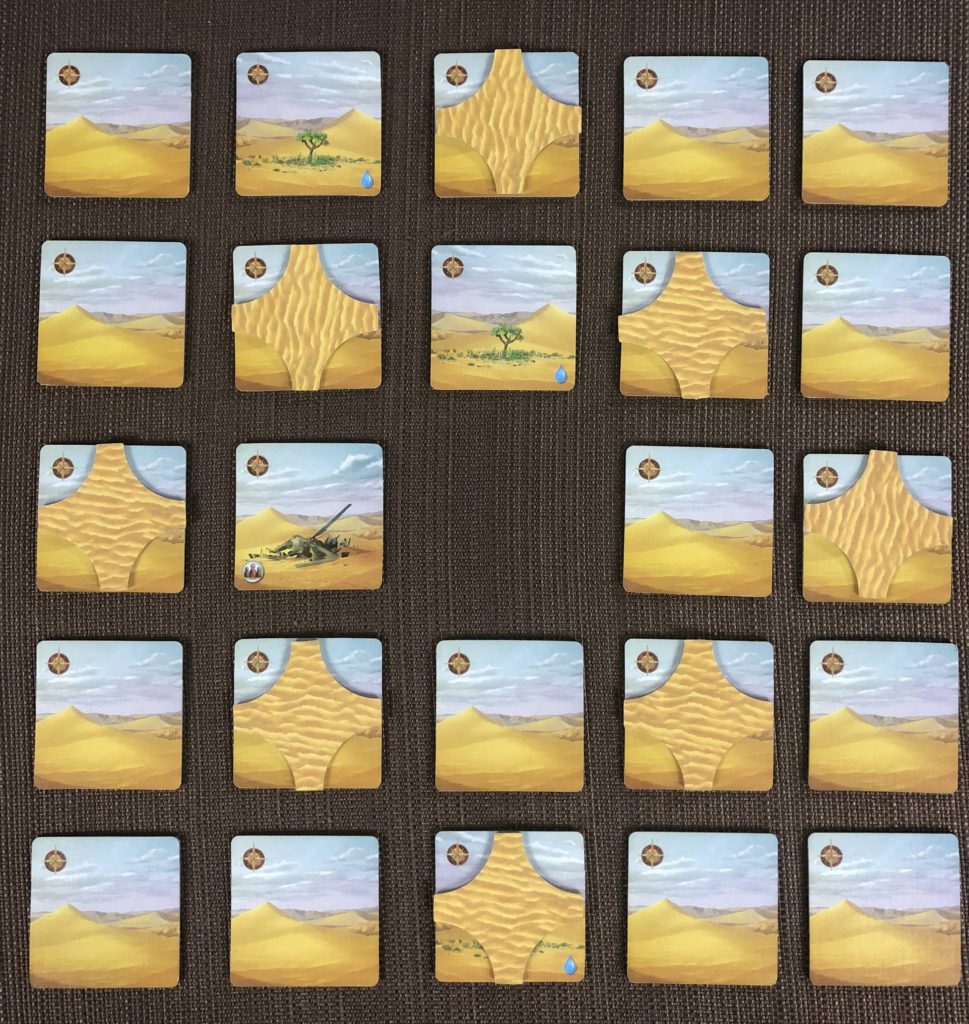
Place your parts to the flying machine nearby. Your team will find the parts buried in the desert.
Set the Sand Storm meter according to the number of players and the level of difficulty you wish to place.
Divide the Cards according to their type. The Storm Deck, Equipment Deck, and the Adventurer Cards should be separated and placed near the play area.
Shuffle the 6 Adventurers cards and deal 1 to each player. Take a moment to read your role to your companions. In order to escape, you will need to utilize everyone’s abilities. Each Adventurer has a coloured pawn that corresponds with your card. Your adventurer pawns will be placed on the “helicopter crash” tile.
The thirstiest player goes first and gameplay continues to the left. On every turn, do the following things in order.
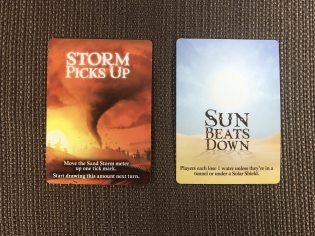
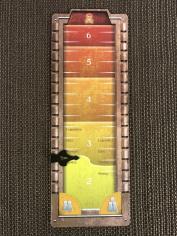
You win the game if our adventurers have gathered all the parts and successfully made it back to the LaunchPad. The pad must be cleared of sand before the airship can take off.
You can lose in 3 possible ways:
I really enjoy cooperative board games. Getting together with friends and working together to solve the problem is very bonding.
The first of this game series is called Forbidden Island. We were able to conquer the game with relative ease. Moving to the Forbidden Desert, however, proved to be significantly more difficult. We lost more than we won but we still enjoyed playing the game. We may have handicapped ourselves a bit in the beginning because we were taking one less action than allowed for each turn.
One of our first playthroughs of Forbidden Desert resulted in three of us hiding in tunnels because we were very thirsty and didn’t want to risk a sun beats down card. While our last companion ventured into the desert alone to become our savior… except we drew two sun beats down cards back to back and he died alone and thirsty.
Forbidden Desert is fun and challenging, but I would highly recommend giving it a shot. It is easy to learn and because it is cooperative, the more experienced players are able to assist the newer players.
Hydrate or die, and I hope you are able to escape the Forbidden Desert.
I have been playing tabletop role-playing games for years. Many people have asked me this very question after I began talking to them about DnD. Most people do not really know anything about the game, rather only what they have heard. “The game involves magic and magic is evil.” “The game is only for nerds… you don’t want to be a nerd, do you?”
I am hoping to give you five reasons why you should play Dungeons and Dragons or other pen and paper games.
I know right? Nerds being social and making friends. Maybe you have moved to a new city and haven’t met anyone yet. Dungeons and Dragons groups meet all over, you just need to find them. Perhaps, some of your closest friends play and you just don’t know.
I have found that many people that play Dungeons and Dragons are friendly and want to share the experience with others. As you play together, your group will form bonds. The first group I was a dungeon master for was a bunch of college students that hadn’t spent a lot of time together. As the group continued to meet, I was able to see friendships and relationships grow.
I have found that people need to bond. One of the strongest ways to bond people together is by shared experiences. Your group of adventurers will be faced with trial after trial. Quests will be fulfilled, characters could get injured, and losses may occur. The party will face moral dilemmas and unfathomable enemies. This experience will forge a bond of friendship.
Some of my groups can’t wait to share their session with family members and friends. They are able to describe how the heroes overcame different hardships. Worlds of imagination are being explored together. This experience may blend into real life. I have seen a quiet and reserved person become outspoken and bold. The experiences in-game can affect you and your friendships at the table.
In Dungeons and Dragons, you take on the role of a hero or villain. Most of the time, you will begin as an average person. Your skills are average and you are not the best in combat. But as you begin to gain experience through fighting enemies, gaining reputation, or earning gold, you will become a powerful hero or villain.
During the character creation phase, I have developed an idea for a character, but have found with good storytelling my character will grow into something new. You get to live a different life through this character and experience a whole new world.
I have found that playing an enjoyable and regular game with friends helps to alleviate stress. Setting aside time for yourself to do something enjoyable will benefit your mental health. Laughing about a critical failure or cheering as a series of extraordinary events become something incredible will give you stories that you will want to share with others.
The shared experience bonds people together. Fighting together, even in an imaginary world, creates bonds that last beyond the table. I know there are a lot of lonely people out there; however, having a group of five people that care about whether you show up each week or not can make an incredible difference in your life.
Cooperative storytelling inspired me to become a dungeon master. As I lay a foundation for the story, the players are able to contribute to how the story continues. Every decision the players make weaves a more intricate story. The party could decide to follow the main storyline as set by the dungeon master or they could take side quests and explore the world before them.
I have played Rise of the Runelords campaign twice. Although I knew how the main story was supposed to progress, I found both playthroughs were a different and satisfying experience. The players and the dungeon master will create unique stories that many players want to share with others.
Dungeons and Dragons may seem nerdy or different, but if you enjoy spending time with friends, exploring fantasy stories or video games, then I would greatly consider finding a party. Adventure awaits!
Many players have asked me, “how hard is it to be a dungeon master?” I usually respond with a few responses. It’s not hard, but it is a lot of research and homework. Or, it’s a lot of fun, but you need to be good at improvising.
Let me tell you a story of how I became a dungeon master because I have found that I prefer it instead of being one of the players.
I started playing Pathfinder Rise of the Runelords with a few friends. My sorcerer was the arcane magic user for our group and I specialized in burning everything!!! He became a bit of a pyromaniac, but I really enjoyed playing him.
He introduced me to the game and proved to be a very entertaining dungeon master. The DM knew the story and brought it to life. When we made mistakes, he invented ways to guard us against a total party wipe. We were taught to think about our social and combat interactions. He convinced us goblins were dumb and may have even sung a goblin song. He played music in the background to add suspense. I believe he did a fantastic job.
I am the leader of a college group at my church. Some of my students were having difficulty bonding during some of our Bible studies. We discussed that I played Pathfinder and after describing the game, several students expressed interest. I decided that I would attempt to run a session for them. It would be a trial run to see if they enjoyed it or not.
I started watching Critical Role to learn from the great Matthew Mercer. I read up on the rules and the storyline. The students learned to create their characters. We decided to hold an intro session that described their background story that led them to Sandpoint(the starting point for the adventure path). Several different tales and stories were weaved together which helped to form their characters and I loved it. I began to improvise and write story hooks and side quests. I became the NPCs, crafted events as the group progressed, imagined new NPCs on the fly and described critical successes and failures. The entire process was exhilarating and it to open a creative side of me that I didn’t know existed.
What I loved most about being a DM is watching people bond over the shared experience. Learning how people function as a group and seeing people come out of their shell.
I would highly suggest if you enjoy improvisation, storytelling, and tabletop role-playing games, then consider trying to DM a session. And if you need some tips or help along the way, please let me know. I would be happy to give some advice to new dungeon masters.
If you have a story to share, feel free to contact me with it. I will be sharing some of my experiences here!
So, is being a dungeon master hard? Yes, but it is completely worth it.

As players, we may our character’s personality and develop its personality as we play. While creating a character, we may also decide what type of personality he will have no matter what happens in the games. And then there is me…
I created a Druid for the Curse of Strahd campaign and developed his personality before knowing anything about the campaign.
(Side note: always read the campaign players guide or description before making all of your character decisions)
I decided that this Druid was going to be determined to keep nature as pure as possible. Which translates to hating anything that warps the natural order of things. Such as vampires, werewolves, and other abhorrent creatures.
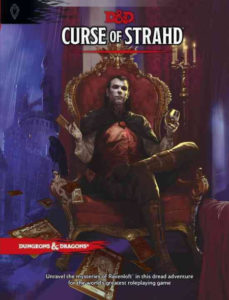
The Curse of Strahd is a gothic horror campaign. Hags, werewolves, and vampires inhabit most of the land. Not exactly the most ideal setting for my character. However, I decided to press on because it could create some interesting scenarios.
Fast forward to a small shack in the woods. We meet a man that locks himself in at night because he doesn’t want to hurt anyone and wants to be left alone. Guess what… he admits to being a werewolf. The rest of the party is all like, “let’s leave him alone,” “He isn’t the Beast we are looking for.” And, I light the shack on fire.
Keep in mind, we are level 1 maybe level 2 with little to no magical weapons. Fighting a werewolf at this level isn’t ideal. We survived, but the rest of the party ended up doing most of the work.
We had a few more scenarios play out, but eventually, my Druid grew emotionally and he began to realize that not everything is as black and white as he saw it. Now if only he knew that prior to the shack, there may have been one more NPC mostly alive in the campaign.